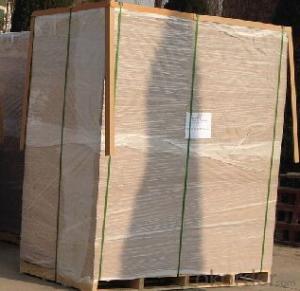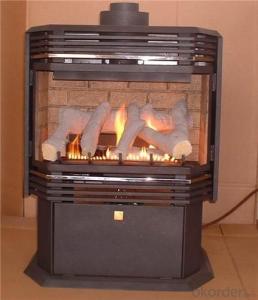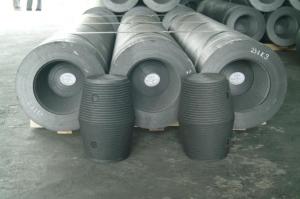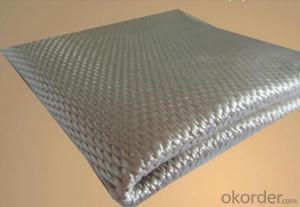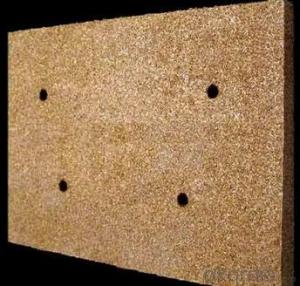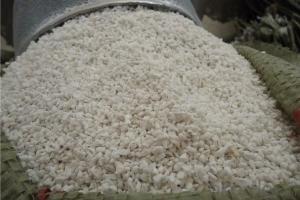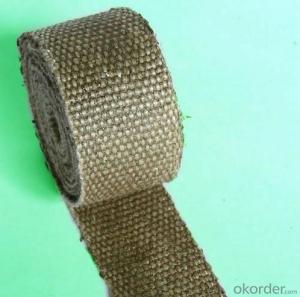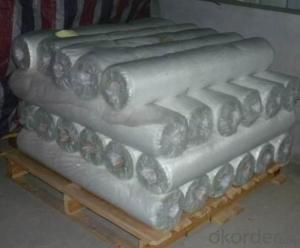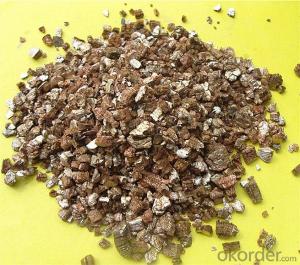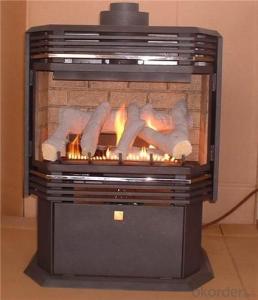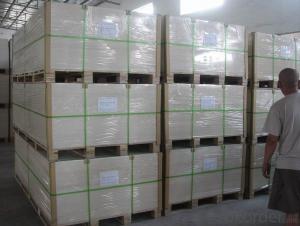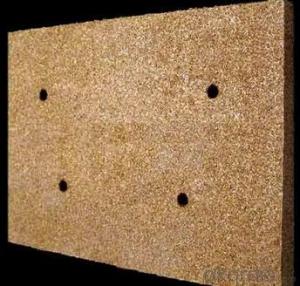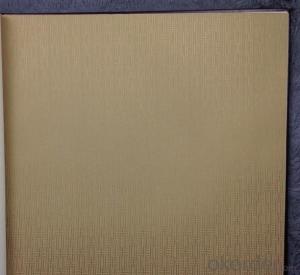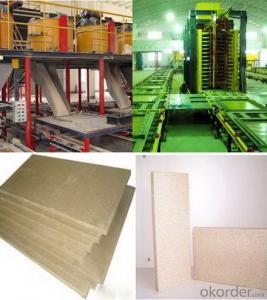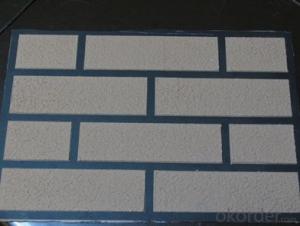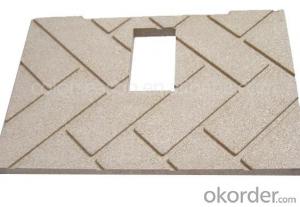water proofing perlite vermiculite board
- Loading Port:
- Tianjin
- Payment Terms:
- TT OR LC
- Min Order Qty:
- 500 pc
- Supply Capability:
- 200000 pc/month
OKorder Service Pledge
OKorder Financial Service
You Might Also Like
Packaging & Delivery
| Packaging Detail: | in carton |
| Delivery Detail: | 15 days after 30% TT deposit |
Specifications
Density 220-+10%
compress strength >=0.49
thermal conductivity 298K-+2K
working temperature 900C
linerashrinkage 923K(650C)
Perlite insulation board
Product introduction:
Perlite insulation board , is also called FEG waterproofing perlite insulation board, its main ingredient is
expanded perlite particle,reinforced fiber ,mixing in heat resistant inorganic natural sepiolite, inorganic
modified binder and high temperature resistant polymer moisture repellent, by the physical synthesis
technology, in the specific temperature condition, pressure forming.
Advantage:
1.light weight,
2.fire-resistant, water proofing, sound proofing, heat insulation character.
3.Good water-proof property,
4.low thermal conductivity,
5.light bulk density, .
6.high strength,
7.excellent chemical stability,
8.non-shrinkage
9.non-deformation
10. any processing, nontoxic.
11.In 1200C tem condition, fire endurance can be up to 90-120 minutes.
Application:
1. Ships, core board of fire door in house, industry furnace, public buildings ‘s roof,
swimming pool, barn, Cold Storage, boiler.
2. Heat and cold project
Specification:
Item | Index |
Density(kg/m3) | 220+-10% |
Thermal Conductivity(w/m.k) | ≤0.065 |
Compression Strength(Kpa) | ≥474 |
Quality Moisture Rate(%) | ≤5 |
Hydrophobicity (%) | 99.2 |
Working Temperature(°C) | -40-900°C |
Common Size(mm) | 600*300 1050*950, Min. Thickness:25mm |
- Q: its a brown, tan, and black snake and it looks like a python but i know its not a python...i need to know what kind of snake this...it had eggs and im not sure what to do about the eggs or the snake..where i live had a lot of snakes when i first moved here...so as i found the snakes i put them in my old fish tank...i was planning on moving them to the creek across the street but they reproduced before i had a chance to do anything with them...i have 3 snakes in the tank and i think the biggest one that looks like the python had them because that snake will not move away from the eggs...i need some help as to what kind of snake im dealing with and as to what to do about the eggs...ur help will be very much appreciated...thank u to anyone that can help me with this problem.
- Perlite. It feels like a hard Styrofoam or a soft limestone when pinched. It's a mineral that is mined and heated to expansion. It is used in commercial potting mixes to keep the soil loose and airy so the roots can grow more freely. If you have very hard dirt in your garden, you can purchase large bags of perlite to mix with peat moss and the existing garden dirt to break up those clumps. It has no nutrictional value for your plants, but it's very beneficial for the root system.
- Q: Is there some reason why I should not funnel vermiculite or perlite into my existing uninsulated house walls? People keep telling me to blow in cellulose, but that process is very messy and sometimes doesn't do a complete fill. Any advice would be appreciated.
- If the egg is deflated looking, try covering it with some moist vermiculite/perlite. Some breeders have also suggested placing a moist paper towel over it. It could be that the humidity is not high enough. Sometimes it takes a couple of days for it to inflate again after being too dry. If the gecko JUST laid it today, give it some time to start checking to see if it's infertile or not. Sometimes you can't see red veins right away, so I'd give it a couple of weeks before checking again. I made my incubator with a styrofoam box, heat mat hooked up to a thermostat, digital thermometer, bowl of water on the heat mat, and a box of eggs in moist vermiculite (wetted the vermiculite then squeezed out the water). For leopard geckos...temperature was set at 83F for mine, but you can have a range of 79-83 for mostly females and 88-90 for mostly males...or in between for a mix. I'd still incubate the egg until it either completely deflates or starts smelling bad.
- Q: I have encountered several dust patches around my warehouse. They are right under holes in the cinder block wall. I didn't know what it was from until i put some holes in the wall and found that this brown dust was inside the blocks. My guess is some type of insulation. Can anyone tell me what this stuff is? Also this warehouse is part of a school. Is it harmful in any way to humans? Thanks for any help you can give me.
- no wash it.vermiculite is a natural earth mineral
- Q: I'm thinking of what incubation substrate I should use I've heard good things about all of them but I've heard vermiculite has asbestos and I don't want my snakes eggs in asbestos. So any recommendations?
- That okorder
- Q: A few weeks ago I planted some little venus fly trap seeds in one cup of peat moss, mixed with one cup of vermiculite. And every other day I give them a spray of distilled water. They're in indirect sunlight in a window that usually stays open. But I've seen no progress, they're not growing.Did I kill them by using the vermiculite?
- Vermiculite will hold more water but tends to bunch together and eventually break up. Perlite will keep it's shape longer, retains moisture and helps aerate the soil.
- Q: I want to start growing mushroom. For the compost I want to use horse Manure and heat it (to pasteurize it).What are some tips? Techniques? What temperature do you cook it at?Thanks!
- any of these type products have chemicals in them that be harmful to your pet i do not like snakes but that ok i dint want to see it suffer either if you put that stuff in there with him you might as well put him in the oven and turn full blast because the fertilizer in that moss will do just that it will cook him alive if you have feed close to you some where that carries horse bedding like sawdust or saw chips anything but ceder chips the oils in it will bother him to pine or some type of hard wood will do great hope this helps
- Q: I‘ve got 12 snake eggs incubating at 80-82 degrees Farenheit. They were laid between April 23 and May 5. I have been keeping them well watered, and they feel plump when I touch them, not squishy like when they were first laid. I know they are fertile, but I don‘t know the signs when they should hatch. The only sign I know of is that slits start appearing in the eggs, but I was told other signs begin in the 3-6 day before they hatch. So, my two questions are when are they likely to hatch, and what are the signs? If you‘ve NEVER incubated Reptile eggs, don‘t give an answer. Snake eggs aren‘t like bird eggs. Thanks all.
- Congrats on your clutch! You're going to have a gorgeous mix of babies. There are a couple signs of imminent hatching with snake eggs. The most obvious is that 3-7 days before hatching, the eggs will seem to deflate or dehydrate a bit. They might look like they need a little more water, but if the substrate (vermiculite, or whatever you have them in) seems just the same as always, *don't* add more water. The other signs are as you mention -- the eggs are very plump and almost springy in the month before hatching, but around the last 10-15 days, they'll be even moreso. You may even see stretch marks forming -- if you examine the shell very closely, it'll seem almost streaky or ridged, almost like it is developing a linear fingerprint-like pattern. Also around this period, the shell becomes quite vulnerable to puncturing. (Once caught an egg with a rough fingernail and lost a hatchling at this stage.) Some people claim the scent of incubating eggs becomes stronger near hatching, more grassy or green-pepper-like. I didn't notice much of a difference. If the eggs were laid over a long period, *don't* slit the other eggs once the first few start to pip. I know ball python owners often slit the eggs a few days in advance, but well-hydrated, healthy baby corns never seem to need the extra help. Plus they're just so easy to accidentally damage while in the egg. Incubation usually takes 65 days, and sounds like you're on approximately day 70. Don't worry, though -- your temperatures are a little on the cool side, so hatchlings might take 80 days or more. Temps in the mid 70s can cause clutches to take around 100 days to hatch (note, however, that survival rates start to suffer at these temps.) Good luck with your clutch!
- Q: whats the best way to over winter dahlia tubers?
- I doubt you will even feel or be able to measure a difference on a in line four. That's a waste of 300-400 bucks. Take that money and buy an exhaust system, chip, and a KN air filter and it will make a bigger difference. (my opinion)
Send your message to us
water proofing perlite vermiculite board
- Loading Port:
- Tianjin
- Payment Terms:
- TT OR LC
- Min Order Qty:
- 500 pc
- Supply Capability:
- 200000 pc/month
OKorder Service Pledge
OKorder Financial Service
Similar products
Hot products
Hot Searches
Related keywords
